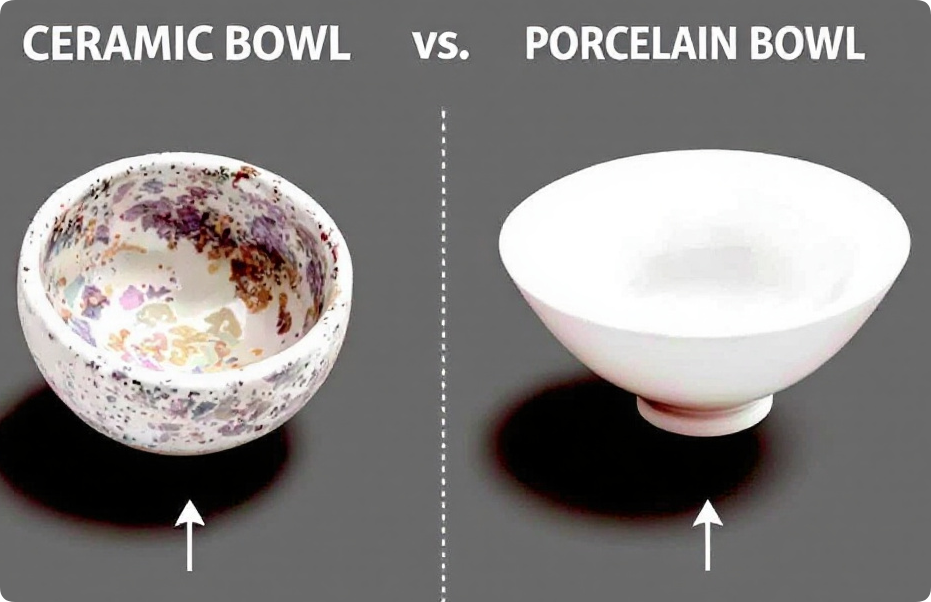When it comes to choosing between ceramic and porcelain bowls, the decision isn’t always straightforward. Both materials are widely used for dinnerware, offering unique qualities that cater to various tastes and needs. This comprehensive guide delves into the differences, advantages, and disadvantages of ceramic and porcelain bowls to help you make an informed choice.
Table of Contents
- What Are Ceramic and Porcelain Bowls?
- Advantages of Ceramic Bowls
- Drawbacks of Ceramic Bowls
- Advantages of Porcelain Bowls
- Drawbacks of Porcelain Bowls
- Practical Applications: When to Choose Ceramic or Porcelain Bowls
- Caring for Ceramic and Porcelain Bowls
- Ceramic vs. Porcelain: Which Is Better?
- Additional Factors to Consider
- Conclusion: The Best Choice for You
What Are Ceramic and Porcelain Bowls?

Ceramic bowls are crafted from natural clay, mixed with other elements, and fired at lower temperatures compared to porcelain. They are often thicker and less refined, with a porous structure. Ceramic dinnerware is versatile and affordable, making it a popular choice for casual settings.
Porcelain bowls, on the other hand, belong to the ceramic family but are made with finer, denser clay like kaolin and fired at much higher temperatures. This process results in a bowl that is smoother, more durable, and non-porous, giving it a polished and premium feel.
Key Differences Between Ceramic and Porcelain Bowls
| Feature | Ceramic Bowls | Porcelain Bowls |
|---|---|---|
| Material | Coarser clay, may include earthenware | Fine kaolin clay, high-quality materials |
| Firing Temperature | Low to medium | High |
| Porosity | More porous, can absorb water | Non-porous, waterproof |
| Durability | Susceptible to chipping and breaking | More durable, chip-resistant |
| Weight | Heavier | Lightweight |
| Appearance | Rustic, handmade aesthetic | Sleek, polished, and elegant look |
| Price | Budget-friendly | Generally more expensive |
Advantages of Ceramic Bowls
- Aesthetic Versatility
Ceramic bowls often exude a warm, handmade charm. With various glazes and finishes, they can match rustic or contemporary table settings. - Cost-Effective
Ceramic is typically less expensive than porcelain, making it accessible for individuals and businesses that need affordable options for everyday use. - Eco-Friendly Option
Many ceramic products are made using sustainable methods, and the material is biodegradable over time. - Customizability
Ceramic bowls can be painted or glazed in a wide range of designs, making them ideal for personalization. - Heat Retention
Ceramic retains heat longer than porcelain, which can keep food warm during meals.
Drawbacks of Ceramic Bowls
- Fragility
Ceramic bowls are more prone to chipping and cracking under stress or impact. - Water Absorption
Their porous nature means they can absorb moisture if not glazed properly. - Limited Durability
They are less likely to withstand long-term wear and tear compared to porcelain.
Advantages of Porcelain Bowls
- Exceptional Durability
Porcelain bowls are less prone to breaking and can withstand frequent use, making them suitable for restaurants and households alike. - Non-Porous Surface
The high firing temperature creates a smooth, impermeable surface that resists stains and odors. - Lightweight Yet Sturdy
Despite being robust, porcelain bowls are lightweight, making them easy to handle and store. - Elegant Design
Porcelain often has a glossy finish and refined appearance, making it a popular choice for formal dining occasions. - Microwave and Dishwasher Safe
Most porcelain bowls are safe for microwave and dishwasher use, adding to their convenience.
Drawbacks of Porcelain Bowls
- Higher Cost
The superior quality and production process make porcelain bowls more expensive than ceramic ones. - Brittle Under Extreme Conditions
Though durable, sudden temperature changes or dropping can still cause porcelain to crack or shatter.
Practical Applications: When to Choose Ceramic or Porcelain Bowls
Scenarios Favoring Ceramic Bowls
- Casual Dining: Perfect for everyday meals with a cozy aesthetic.
- Budget-Conscious Buyers: Ideal for those who want cost-effective dinnerware.
- Custom Designs: Suitable for personalized gifts or branded use.
Scenarios Favoring Porcelain Bowls
- Formal Events: Best for occasions that demand elegance and sophistication.
- High-Traffic Use: With superior durability, porcelain bowls are great for restaurants and hotels.
- Frequent Cleaning: Their non-porous surface makes them stain-resistant and easy to clean.
Caring for Ceramic and Porcelain Bowls
Proper care ensures the longevity of both ceramic and porcelain bowls.
- Ceramic Bowls:
- Avoid placing them in high-temperature ovens or freezers.
- Handwashing is preferred for delicate, unglazed pieces.
- Porcelain Bowls:
- Use gentle dishwashing cycles to maintain the glossy finish.
- Store carefully to prevent chipping during stacking.
How To Take Stains Out Of A Ceramic Or Porcelain Bowl
Ceramic vs. Porcelain: Which Is Better?
The answer depends on your priorities:
- Choose ceramic bowls for their rustic charm, affordability, and customizable designs.
- Opt for porcelain bowls for their durability, elegant appearance, and suitability for frequent use.
Quick Summary
- For casual dining and personalized gifts: Ceramic.
- For formal dining and long-term durability: Porcelain.
Additional Factors to Consider
- Heat Resistance: Porcelain is better for microwave use, but ceramics are excellent for retaining heat.
- Weight Preferences: If you prefer lightweight dinnerware, porcelain is a better choice.
- Cultural Context: In Asian cultures, porcelain is often preferred for tea ceremonies and formal dining.
Conclusion: The Best Choice for You
Ceramic and porcelain bowls both have unique qualities that make them suitable for different purposes. Understanding their features and applications ensures you pick the one that best suits your lifestyle or business needs.
Whether you value cost-effectiveness or a premium finish, selecting the right bowl can enhance your dining experience.

